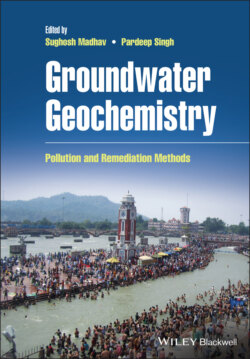Читать книгу Groundwater Geochemistry - Группа авторов - Страница 13
1.1 Introduction
ОглавлениеWater resources are one of the essential resources of nature. Being fluid, water’s nature allows it to flow into the low‐pressure zone from the high pressure. On the surface, it is found in the geographical form of rivers and streams, and it flows with varying pace depending on the gravity, pressure, and geography of the area. The contact time of water with its geographical space is lower due to pace in surface water flow, and this is the reason it has far fewer or negligible geogenic contaminants compared to anthropogenic contaminants. In contrast, the subsurface water moves at a very slow pace (a few millimetres a day) through the pore spaces or cracks of the soil and rocks. Sometimes the water becomes stagnant, like in perched aquifers and in the impermeable hard rock terrains. This very low movement of aquifer waters (groundwater) allows more time for water to interact with the surrounding natural environment, which may be hard rock, soft rock, or soil and enriched with the geogenic constituents. The groundwater contamination largely depends on the soil geochemistry through which water travelled before reaching the aquifers (Achary 2014a). Hydrological processes are important in governing groundwater contamination. Minerals mobilize in the aquifer system in response to the constituents and minerals present in the rock matrix and their depositional history, along with geochemical conditions (Garduño et al. 2011).
Approximately 1.5 billion people are dependent on underground sources of water (Mukherjee et al. 2012); this is why geogenic pollution has become a major threat to groundwater contamination. Groundwater contaminated by the rock–water interaction has resulted in geologically induced constituents such as As, F, Fe, Mn, Se, Cr, etc. Long‐term intake of F‐contaminated groundwater leads to severe fluorosis, both dental and skeletal, as well as a range of non‐skeletal effects. As‐contaminated water caused severe health effects such as arsenicosis, skin cancer, respiratory problems, and other cancers. The commonly used remedial techniques for the removal of As and F from groundwater are membrane separation, ion exchange resins, coagulation‐precipitation (also known as Nalgonda technique), and adsorption filter beds. It is essential to understand the operational parameters before adopting these potential techniques for remediation such as the local water demand, water quality parameters, initial concentration, and daily basis water use patterns. As‐contamination is highest in the Indo‐Gangetic plain in the eastern and northeastern parts of India.
Geogenic contaminants, including arsenic, fluoride, and iron are commonly observed in nature. In India, the foremost geogenic contamination in aquifers is Arsenic and Fluoride (Garduño et al. 2011). Other contaminants include nitrate, phosphate, heavy metals and trace metals which may result of the human activities including domestic savage, septic tank, industrial effluents and agricultural practises (Madhav et al. 2018). In India, there are several states and districts which are affected by geogenic contamination such as Arsenic (10 states and 68 districts), Fluoride (20 states and 276 districts), and Iron (24 states and 294 districts) (CGWB 2014).
